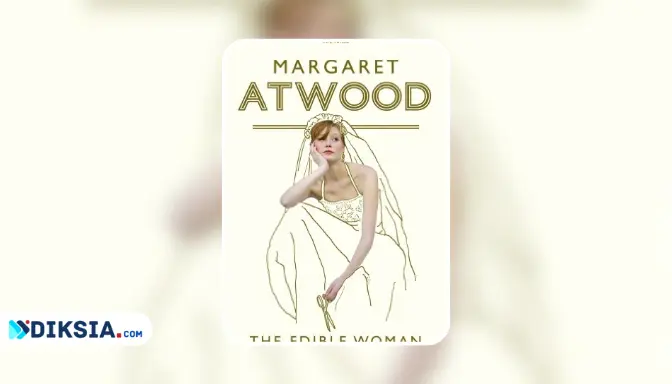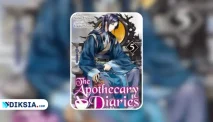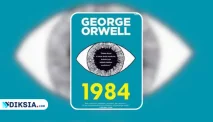Diksia.com - If you are looking for a book that will make you laugh, think, and question the norms and expectations of contemporary culture, then you might want to check out The Edible Woman by Margaret Atwood.
This is the debut novel of the acclaimed Canadian author, who is best known for her dystopian masterpiece The Handmaid’s Tale. The Edible Woman is a witty, subversive, and hilarious story of a young woman who rebels against the pressures of marriage, consumerism, and conformity in the 1960s.
Introduction
The Edible Woman was first published in 1969, and it is considered one of the earliest examples of feminist literature. It explores the themes of gender roles, identity, sexuality, and autonomy through the lens of humor and irony. The novel has been praised for its originality, style, and insight into the human condition.
The protagonist of the novel is Marian McAlpin, a market researcher who lives a seemingly normal and stable life. She has a steady job, a serious fiancé named Peter, and a group of friends who share her interests and values. However, things start to change when she gets engaged to Peter, who represents everything that society expects from a successful man.
As Marian prepares for her wedding, she begins to feel trapped and suffocated by the demands and expectations of her role as a wife. She starts to lose her sense of self and identity, and she develops a strange aversion to food.
She feels like she is being consumed by Peter and by the society that wants to mold her into a passive and obedient woman. She decides to rebel against this fate by rejecting food, breaking off her engagement, and pursuing her own desires.
Book Details
- Title: The Edible Woman
- Author: Margaret Atwood
- Genres: Feminism, Satire, Dystopia
- Chapters: 22
- Language: English
- Publisher: McClelland & Stewart
- Publication date: 1969
- Rating: 4.2 out of 5 stars on Goodreads
- Awards: Governor General’s Award for Fiction (1969)
Recommended Audience
The Edible Woman is suitable for readers who enjoy witty and clever novels that challenge the status quo and offer a fresh perspective on social issues. It is also recommended for fans of Margaret Atwood’s other works, such as The Handmaid’s Tale, Alias Grace, and The Blind Assassin.
Overview
The Edible Woman is divided into three parts, each corresponding to a different point of view. The first part is narrated by Marian in the first person, as she introduces her life and her relationship with Peter. The second part switches to the third person, as Marian becomes more detached from herself and her surroundings. The third part returns to the first person, as Marian regains her voice and her agency.
Plot Summary
In the first part of the novel, Marian works as a market researcher for Seymour Surveys, where she conducts interviews and analyzes data. She lives with her roommate Ainsley Tewce, who works as a tester for an electric toothbrush company. Ainsley is obsessed with having a baby without getting married or having a father figure for her child. She plans to seduce Len Slank, a naive and immature man who works at the same company as Marian.
Marian also has a group of friends who are mostly single women in their twenties. They are Clara Bates, who is married to Joe Bates and has three children; Emmie Storch, who is an art teacher; Lucy Sladekova, who is an immigrant from Czechoslovakia; and Trevor Jordan, who is an engineer and Lucy’s boyfriend. Marian often feels alienated from her friends because they seem to have different goals and lifestyles than hers.
One day, Marian meets Peter Wollander at a party hosted by Trevor. Peter is a lawyer who works for a prestigious firm. He is handsome, charming, confident, and ambitious. He immediately takes an interest in Marian and asks her out. Marian agrees to date him because he seems like a perfect match for her. They soon fall in love and get engaged.
However, after their engagement party, Marian starts to feel uneasy about her future with Peter. She feels like she is losing control over her life and becoming dependent on him. She also notices that he treats her like an object rather than a person. He buys her expensive gifts that she doesn’t need or want, he makes decisions for her without consulting her, and he expects her to quit her job and become a housewife after they get married.
In the second part of the novel, Marian’s discomfort with her situation grows. She begins to have nightmares and hallucinations about being eaten by Peter or by other people. She also develops a phobia of food, especially meat and eggs. She feels like she is being consumed by the society that wants to turn her into a passive and obedient woman. She tries to hide her problem from Peter and from her friends, but they notice that she is losing weight and acting strangely.
Meanwhile, Ainsley succeeds in getting pregnant by Len, who is unaware of her scheme. She tells him that she is going to have an abortion, but she actually plans to keep the baby and raise it alone. Len is devastated and angry, and he breaks up with Ainsley. Ainsley also tells Marian about her plan, and Marian is shocked and disgusted by her manipulation of Len.
Marian also meets Duncan, a graduate student who is writing a thesis on folklore and mythology. He is eccentric, cynical, and unpredictable. He likes to hang out in laundromats and watch other people’s clothes. He also likes to play games with Marian and test her reactions. He is attracted to Marian because he thinks she is different from other women. He invites her to his apartment, where he shows her his collection of paper cutouts of women that he calls his \”harem\”.
In the third part of the novel, Marian decides to break off her engagement with Peter. She realizes that she doesn’t love him and that she doesn’t want to live the life that he has planned for her. She also realizes that she has been suppressing her own personality and desires for too long. She tells Peter that she can’t marry him, and he reacts with anger and disbelief. He accuses her of being selfish and crazy, and he tries to force her to eat a cake that he has bought for her as a symbol of their relationship.
Marian refuses to eat the cake, and she runs away from Peter’s apartment. She goes to Duncan’s apartment, where she finds him with his friend Fisher. They are playing a game of cards with the paper cutouts of women. Marian joins them, and she picks the card that represents herself. She then eats the paper cutout, symbolizing her reclaiming of her identity and autonomy. She feels liberated and happy, and she kisses Duncan.
The novel ends with Marian leaving Duncan’s apartment and walking down the street. She feels hungry for the first time in a long time, and she decides to buy some food from a street vendor. She also decides to quit her job at Seymour Surveys and look for something more fulfilling. She thinks about her future, which is uncertain but exciting.
Characters and Character Development
Marian McAlpin
The protagonist of the novel. She is a market researcher who lives a seemingly normal and stable life until she gets engaged to Peter. She then starts to rebel against the pressures of marriage, consumerism, and conformity by rejecting food and breaking off her engagement. She regains her sense of self and identity by eating a paper cutout of herself at the end of the novel.
Peter Wollander
The antagonist of the novel. He is a lawyer who works for a prestigious firm. He is handsome, charming, confident, and ambitious. He falls in love with Marian and proposes to her. He represents everything that society expects from a successful man. He treats Marian like an object rather than a person, and he tries to control her life and choices.
Ainsley Tewce
Marian’s roommate who works as a tester for an electric toothbrush company. She is obsessed with having a baby without getting married or having a father figure for her child. She plans to seduce Len Slank, who works at the same company as Marian. She succeeds in getting pregnant by him, but she lies to him about having an abortion. She represents the opposite extreme of Marian’s situation: a woman who rejects marriage but embraces motherhood.
Duncan
A graduate student who is writing a thesis on folklore and mythology. He is eccentric, cynical, and unpredictable. He likes to hang out in laundromats and watch other people’s clothes. He also likes to play games with Marian and test her reactions. He is attracted to Marian because he thinks she is different from other women. He invites her to his apartment, where he shows her his collection of paper cutouts of women that he calls his \”harem\”. He represents an alternative perspective on gender roles and relationships.
Clara Bates
One of Marian’s friends who is married to Joe Bates and has three children. She used to be an active and adventurous woman, but she has become exhausted and overwhelmed by motherhood. She represents the consequences of traditional marriage and family for women.
Emmie Storch
One of Marian’s friends who is an art teacher. She is single and single. She is independent and confident, but she also feels lonely and insecure. She represents the possibility of a career-oriented and self-reliant woman.
Lucy Sladekova
One of Marian’s friends who is an immigrant from Czechoslovakia. She is a librarian and the girlfriend of Trevor Jordan. She is smart and cultured, but she also feels out of place and discriminated in Canada. She represents the challenges of adapting to a new culture and society.
Trevor Jordan
One of Marian’s friends who is an engineer and the boyfriend of Lucy Sladekova. He is friendly and generous, but he also has a tendency to be insensitive and patronizing. He represents the typical male attitude towards women in the 1960s.
Len Slank
A naive and immature man who works at the same company as Marian. He is the target of Ainsley’s scheme to get pregnant by him. He is unaware of her plan, and he believes that she loves him. He represents the victim of female manipulation and deception.
Fisher
Duncan’s friend who is also a graduate student. He is more serious and rational than Duncan, but he also shares his interest in folklore and mythology. He helps Duncan with his game of cards with the paper cutouts of women.
Theme and Message
The main theme of The Edible Woman is the oppression and exploitation of women in modern society. The novel exposes the various ways that women are dehumanized, objectified, and consumed by men, by the media, by the market, and by themselves. The novel also shows how women can resist and challenge these forces by asserting their individuality, autonomy, and creativity. The novel sends a message that women are not edible, but rather human beings who deserve respect, freedom, and happiness.
Writing Style
The Edible Woman is written in a witty, ironic, and humorous style that contrasts with the serious and dark subject matter. The novel uses various literary devices, such as symbolism, imagery, metaphor, satire, parody, and allegory, to convey its meaning and message. The novel also experiments with different points of view, switching from the first person to the third person and back to the first person, to reflect Marian’s psychological state and development.
Pros and Cons
Pros:
- Thought-provoking
- Well-written
- Insightful
- Humorous
Cons:
- Slow-paced at times
- Some may find the ending unsatisfying
Comparison to Other Works
The Edible Woman can be compared to other works that deal with similar themes or topics, such as:
- The Bell Jar by Sylvia Plath: A semi-autobiographical novel that depicts the mental breakdown of a young woman who struggles with depression, sexism, and social pressure in the 1950s.
- The Stepford Wives by Ira Levin: A horror novel that portrays a suburban town where all the women have been replaced by robotic duplicates who are obedient and submissive to their husbands.
- The Handmaid’s Tale by Margaret Atwood: A dystopian novel that depicts a totalitarian regime where women are enslaved and exploited for their reproductive functions.
- Fight Club by Chuck Palahniuk: A cult novel that depicts a violent underground movement that rebels against consumerism, conformity, and emasculation in modern society.
Where To Read Book
The Edible Woman is available in a variety of formats, including paperback, hardcover, and ebook. It can be purchased from most major retailers, such as Amazon, Barnes & Noble, and Books-A-Million.
You can read The Edible Woman online or offline from various sources, such as:
- Amazon Kindle: You can buy the ebook version of The Edible Woman from Amazon Kindle for $9.99. You can also read a free sample of the book before buying it.
- Audible: You can listen to the audiobook version of The Edible Woman from Audible for $14.95. You can also get a free trial of Audible for 30 days.
- Goodreads: You can read reviews, ratings, quotes, trivia, and discussions about The Edible Woman from Goodreads. You can also join groups or clubs that are reading or have read the book.
- Library: You can borrow the print or digital version of The Edible Woman from your local library for free. You can also request or reserve the book if it is not available.
Conclusion
The Edible Woman is a brilliant debut novel by Margaret Atwood that explores the themes of gender roles, identity, sexuality, and autonomy through the lens of humor and irony. The novel tells the story of Marian McAlpin, a market researcher who rebels against the pressures of marriage, consumerism, and conformity by rejecting food and breaking off her engagement.
The novel is a witty, subversive, and hilarious satire of modern society that challenges the norms and expectations of contemporary culture. The novel is also a powerful and inspiring feminist statement that celebrates the individuality, creativity, and freedom of women.
I hope you enjoyed reading this article about the book/novel review of The Edible Woman by Margaret Atwood. If you did, please share it with your friends and family who might also be interested in this book. If you have any questions, comments, or feedback about this article, please feel free to leave them below. Thank you for your time and attention.






